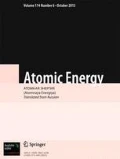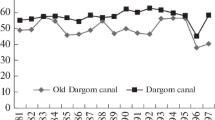Conclusions
-
1.
The Soviet Union is one of a large number of countries interested in solving the problem of water supplies to regions with a lack of fresh water. Allowing for the scale of existing demands for water and their prospective growth, an important factor in solving the popular-economic problem is that of using nuclear power reactors of already-developed types, together with desalination systems operating on the principle of distilling sea water (Black, Caspian, Azov, and Aral seas).
-
2.
The solution of the problem of economically producing fresh water (3 to 5 kopecks/m3) must be sought along the lines of creating powerful and superpowerful nuclear installations simultaneously producing electrical power, heat, and fresh water, with a water production rate of the order of hundreds of thousands and even millions of cubic meters per day. Advances in power reactor construction and the technology of distilling salt water confirm that the technological means for creating such installations do in fact exist.
-
3.
Considering the extremely large scale of fresh-water and power requirements in the USSR and also the rigid demands applicable to the economy of producing these (the minimum economical requirements imposed on triple-purpose installations), it may be said that the most promising sources of heat for such installations are fast reactors and thermal reactors of channel construction (water—graphite). Preliminary technological-economical estimates show that, under Soviet conditions, the economical competitiveness of triple-purpose installations starts from specific thermal powers of reactors of the types indicated of the order of several millions of kW, which are already catered for in power-reactor construction.
Similar content being viewed by others
Literature Cited
T. Cramer, Nucleonics, No. 11, 58 (1966).
G. Rey, Nucleonics, No. 11, 41 (1966).
A. I. Churin and V. A. Klyachko, Vestn. Akad. Nauk SSSR, No.6 (1965).
Yu. I. Koryakin and A. A. Loginov, At. Énerg.,20, 232 (1966).
F. P. Zaostrovskii et al., Soviet Contribution to the First International Conference on Water Desalination [in Russian], Washington, (Oct.3–9, 1965).
V. F. Kovalenko, Thermal Desalination of Sea Water [in Russian], Transport, Moscow (1966).
I. M. Sinev, B. B. Baturov, and V. M. Shmelev, Paper No. 294, presented by the USSR to the Third International Conference on the Peaceful Uses of Atomic Energy [in Russian] (Geneva, 1964).
Additional information
Translated from Atomnaya Énergiya, Vol. 25, No. 5, pp. 394–402, November, 1968.
Rights and permissions
About this article
Cite this article
Churin, A.I., Klyachko, V.A., Koryakin, Y.I. et al. Combination of large atomic power stations with desalination plants. At Energy 25, 1208–1215 (1968). https://doi.org/10.1007/BF01239689
Issue Date:
DOI: https://doi.org/10.1007/BF01239689




